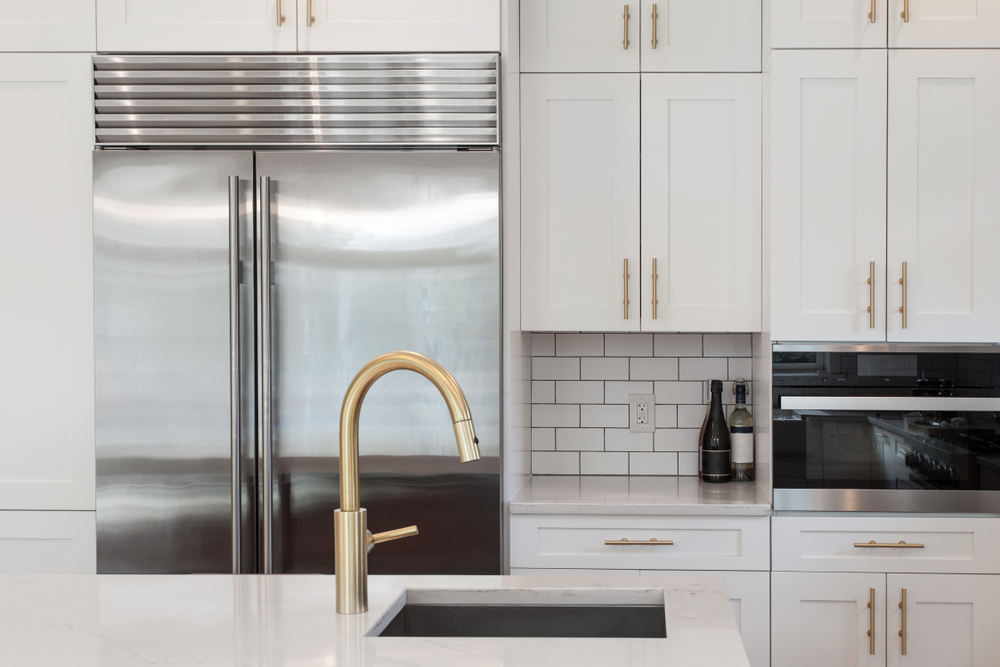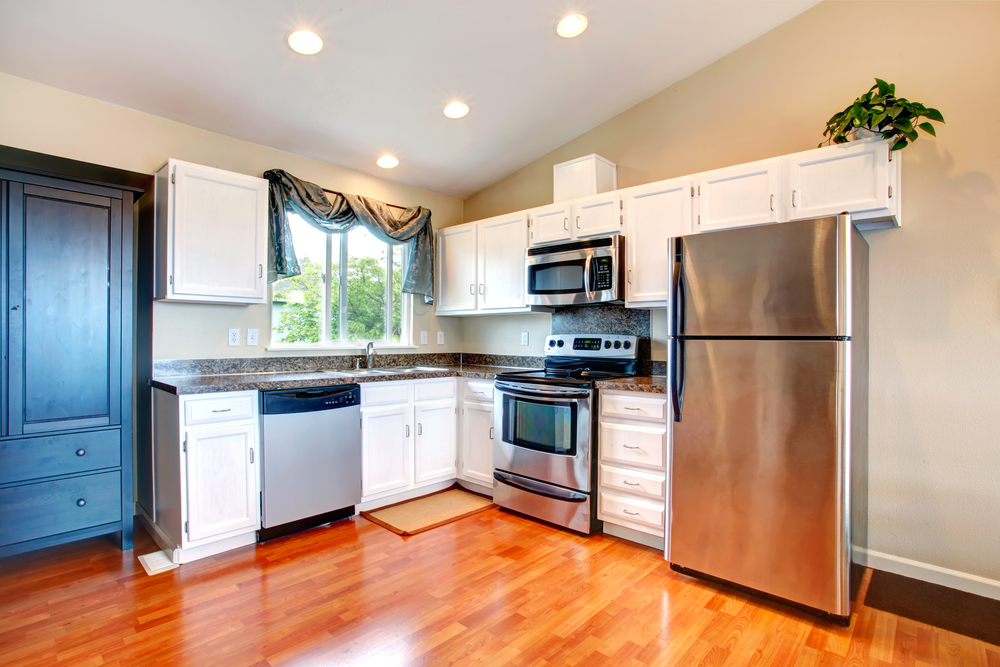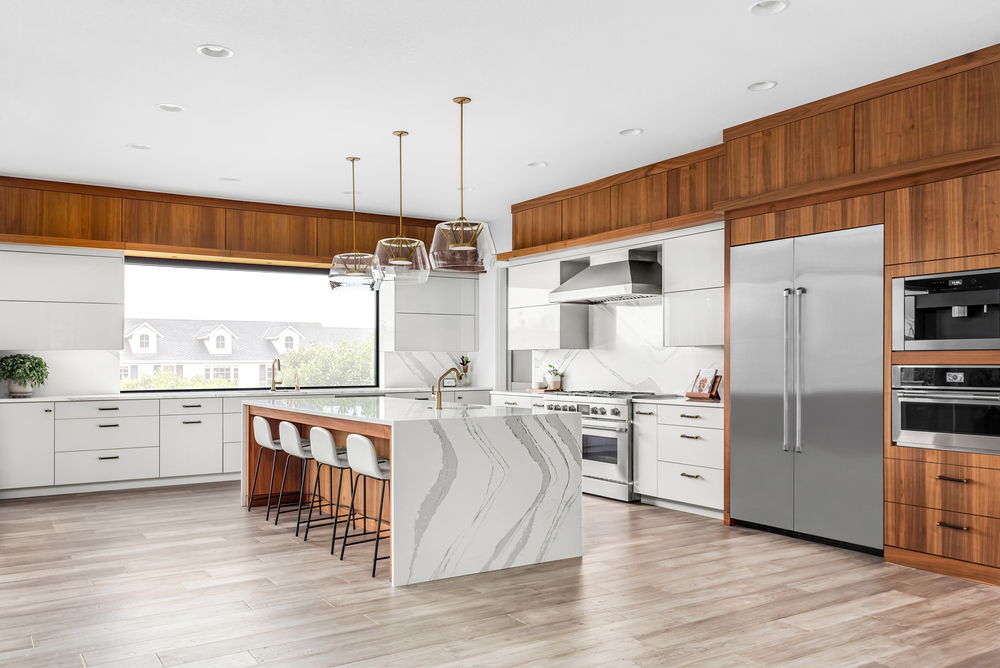Redoing your kitchen is exciting because you can upgrade appliances to be more energy-efficient and attractive. But understanding how your kitchen appliances need to fit in around your cabinets can take a lot of research and effort.
Understandably, you want your cabinets and appliances to line up, making your kitchen look large and expansive. But in most cases, your refrigerator is going to stick out from the counter and cabinets.
Many people think it’s an eyesore to have their refrigerator sticking out beyond the cabinets. In that case, you can invest in a counter depth refrigerator. Installing these appliances gives your kitchen a sleek look.

A Refrigerator That is Mostly Flush with Surrounding Cabinets
However, having a refrigerator stick out beyond the kitchen cabinets isn’t necessarily a bad thing. Read on to find out information like:
Standard refrigerators stick out beyond the cabinets. They need some extra space for the door to open fully. If a counter or cabinet is in the way, you won’t be able to open the door the full 90 degrees. When the door doesn’t open completely, you can’t reach all internal areas of your fridge.
You can prevent this issue by putting your refrigerator at the end of the row of kitchen cabinets. This position allows the door to open into empty space.

Make Sure There is Room to Open the Refrigerator Door
You can also leave some space between the side of the fridge and the counter next to it, so there’s a gap to open into. Otherwise, the fridge door will bump into the cabinet and won’t open all the way. This friction can also cause your countertops and cabinetry to deteriorate.
A refrigerator is typically 30 to 36 inches deep. This measurement includes the doors and handles, so you get an idea of how far it will come out from the kitchen wall. It’ll hold a lot of food on the interior, but it looks bulky compared to a counter-depth fridge.
If you need the storage space of a standard depth refrigerator but want it to suit your kitchen aesthetic, you can try to find more attractive models. Freestanding refrigerators come in different styles, such as:
A French door refrigerator has two top doors for the fridge section and one or two freezer drawers at the bottom. The two doors require less clearance to open completely, so it’s a good choice if you want them to line up with your cabinets.
Side-by-side refrigerators have two doors, just like French door refrigerators. But one door is the fridge section, and the other is the freezer. Each door is as tall as the fridge itself, with no drawers at the bottom of the appliance. Side-by-side fridges often have built-in ice and water dispensers in the door, which is a nice feature to detract from it sticking out from the cabinets.
Top-freezer refrigerators are the most common type. The fridge takes up the bulk of the appliance, and there’s a smaller freezer compartment on top. These models usually have handles on the left side of the doors, opening towards the right, so you should consider this when buying a new fridge.

A Refrigerator with Cabinets Above and to the Side
A bottom-freezer refrigerator is similar to a French door fridge because it has a freezer drawer at the bottom. However, instead of two doors opening into the refrigerator compartment, there’s only one. As with top-freezer fridges, these appliances usually have handles on the left side of the door and open to the right.
Some manufacturers make top-freezer or bottom-freezer fridges with handles on the right side of the doors. These will open to the left, so you can install them on the opposite end of your kitchen cabinets. Getting doors that open a certain way can help ensure the fridge fits in best with the surrounding cabinetry.
If you’re redoing your kitchen completely, you should look into counter-depth fridges. Most counters are 25.5 inches deep, but they can range from 24 to 26.5 inches deep. This measurement might make you think that counter-depth refrigerators also range from 24 to 26.5 inches deep, but that’s not exactly the case.
A counter-depth refrigerator might be 25 inches deep for the fridge itself, but the doors can add an inch or so to that figure. The handles stick out into the room even more.
You also have to consider the space behind the fridge. There’s an electric cord, cooling wires, an ice maker hose, and other accessories. These items make it hard to push the refrigerator flush against the wall.
The manufacturers aren’t trying to con you with the description of “counter-depth,” but it’s important to know what they actually mean with that title.
In reality, a counter-depth fridge might be 24 inches for the cooling compartment only. When you add the doors and space away from the wall, you’ll already be 27.5 inches deep. The handles will add another two to three inches. So, even though the fridge claims it’s counter-depth, it’s closer to 30 inches.
You should also consider that many counter-depth fridges are taller to ensure they’re still giving enough internal storage space. If you fit a built in refrigerator between built-in cabinets, you need to make sure there’s enough room at the top.
While counter-depth fridges are slightly shallower than standard, you’ll need to measure your cabinets and counters carefully. Knowing the specific dimensions of the refrigerator tells you more than the classification of “counter-depth.”
For example, the previously-mentioned French door refrigerator doesn’t require as much range to open the doors. You might find that it offers just as much internal cooling space and doesn’t stick out like a top-freezer fridge. Buying a refrigerator with the right dimensions might save you some money compared to buying one labeled “counter-depth.”
You need to leave some space around the refrigerator to protect the surrounding cabinetry and improve airflow. Even built in refrigerators require at least one inch of space at the back of the appliance. It’s best to leave one inch at the top of the fridge, too, because the heat dissipates there.
The general rule is that you need two inches of clearance on the hinge side of the fridge. This gives the door room to open fully without bumping into the cabinets, countertops, or wall. Doors that don’t open all the way prevent access to drawers and bins inside the fridge.
If you’re upgrading your kitchen to include a built-in refrigerator, make sure you’re giving plenty of space around the top and back for safe airflow. Choosing counter depth fridges or allowing space between the refrigerator and cabinets will help you access everything inside.
